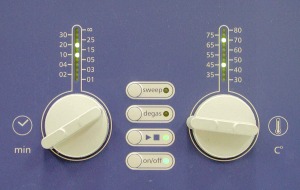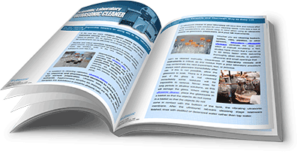Posts by Rachel Kohn
Understanding Ultrasonic Cleaning Chemistries
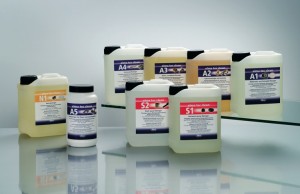 While most of our ultrasonic cleaning posts provide practical advice on how to clean specific items there’s more to the science of the process. In fact effective ultrasonic cleaning is a combination of ultrasonic frequency and power, the temperature of the cleaning solution, the time it takes to complete the job, post-cleaning procedures if required, and cleaning solution chemistry.
While most of our ultrasonic cleaning posts provide practical advice on how to clean specific items there’s more to the science of the process. In fact effective ultrasonic cleaning is a combination of ultrasonic frequency and power, the temperature of the cleaning solution, the time it takes to complete the job, post-cleaning procedures if required, and cleaning solution chemistry.
Three Cleaning Solution Chemistries
A wide variety of cleaning solution chemistries are on the market but just about all commonly used solutions fall into three categories: alkaline, acidic and neutral. While terms like alkaline and acidic may cause some initial concern we are confining our examples to highly diluted biodegradable … Read the rest
A Primer on HPLC Flowmeters
High performance liquid chromatography – HPLC – is very often the method of choice for analyzing pharmaceutical compounds starting with R&D and continuing into manufacturing. Among other things it is used to
- Check candidate drugs for purity
- Monitor changes in pharmaceutical intermediates during chemical synthesis scale up
- Test the stability and dissolution of formulations in development and
- Support quality control in final drug products
Identifying an analyte by HPLC is based on accurate and reproducible column retention time as it passes through an HPLC system. Reproducible retention time is critical and depends on uniform, reproducible HPLC pump flow rates. A leak developing or other malfunction in the HPLC system will result in analysis errors. Obviously, then, continuous testing is necessary to insure that the HPLC system is properly calibrated. This is called operational qualification. OQ starts before the HPLC system is put into use and as part of ongoing system … Read the rest
An Ultrasonic Cleaner Design for Food Laboratories
Food laboratory technicians charged with cleaning sieves used to inspect raw materials for correct grain size may welcome a specially designed ultrasonic cleaner developed by acoustic R&D engineers at Elma Ultrasonic in collaboration with food lab personnel at two locations.
The result of this collaboration is the Elma S50R ultrasonic cleaner available from Tovatech. It is optimized for sieve cleaning, but also for degassing HPLC solvents and for sample preparation involving difficult-to-dissolve substances. A unique feature of the S50R is its built-in programming: food scientists can select three programs by pressing the corresponding key on the cleaner’s control panel: sieve cleaning, degassing and sample prep. There is also an on-off key for standard cleaning and a timer showing set and remaining time.
Sieve Cleaning Challenges Solved
While ultrasonic cleaning is safer and gentler than using brushes to dislodge particles trapped in lab sieves thoroughness has been a problem due to … Read the rest
How Ultrasonic Cavitation Bubbles Scrub
Pardon us for the take-off on a well-advertised household cleaner. We have many posts describing how the implosion of cavitation bubbles in an ultrasonic cleaner solution removes contaminants from wetted surfaces. Here we’ll take a look at what happens at the bubble/surface interface in an ultrasonic cleaner.
Airless Bubbles
Let’s start by saying that unlike the household cleaner bubbles cavitation bubbles have no “air” inside. Instead they have a vacuum. The nitty-gritty of how is not as important as what happens.
Except to say in brief, cavitation bubbles are created by ultrasonic transducers bonded to the bottom and/or sides of the ultrasonic cleaner tank. The generator-driven transducers cause a vibration on the tank surface to produce sound waves in the cleaning solution. This causes compression and expansion in the liquid leading to cavitation bubbles that implode violently and produce shock waves radiating from the site of the collapse.
What is … Read the rest
How to Remove Jewelry Polishing Compounds
Watch case manufacturers, class ring manufacturers, earring manufacturers, body jewelry manufacturers and other quality jewelry manufacturers with broad markets can quickly and efficiently remove jewelry polishing compounds with an industrial ultrasonic cleaner. Following the removal of jewelry polishing compounds final cleaning can be accomplished with the ultrasonic cleaner and/or steam cleaning before products are shipped.
Why Ultrasonic Jewelry Polish Removal?
In a word: efficiency. Ultrasonic cavitation, the implosion of microscopic bubbles against the surface of the jewelry, safely and quickly dislodges and carries away jewelry polishing compounds and other dirt from all surfaces including those difficult or impossible to remove by manual methods. The action is performed in an ultrasonic cleaning tank filled with a biodegradable cleaning solution excited by ultrasonic transducers powered by a generator.
Using an Ultrasonic Cleaner in Jewelry Manufacturing
The equipment can be used to perform several functions … Read the rest
How to Position Parts in an Ultrasonic Cleaner
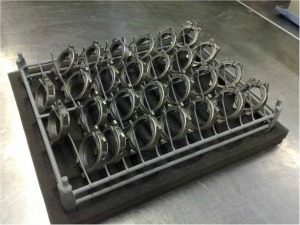
Correct parts positioning in an ultrasonic cleaner is as important as the ultrasonic cleaning frequency and ultrasonic cleaning solution formulation. Yet of these three criteria improper parts positioning is often the cause of unsatisfactory results or extended time in the cleaning solution.
Don’t Fight Cavitation
Better said, don’t impede cavitation action. Cleaning is accomplished by the violent implosion of minute bubbles created in the cleaning solution by ultrasonic transducers. The cleaning action occurs on all surfaces wetted by the solution as sound waves migrate upward through the solution from the bottom of the ultrasonic cleaner tank and reflect back down from the solution surface. This suggests that putting too much product in the cleaning baskets is not a good idea because it will impede sound reflection. At Tovatech we recommend a 1 to 2 inch space between the tank walls and parts in … Read the rest
Tips on Ultrasonic Rinsing Systems
Here at Tovatech we get many questions on selecting correct ultrasonic cleaners and ultrasonic cleaning solutions. Sometimes overlooked by customers and prospects is the importance of rinsing the products after they emerge from the ultrasonic cleaning bath. In fact, in many instances, especially with precision or delicate products, ultrasonic rinsing is just as important as the cleaning operation itself.
Why Consider Ultrasonic Rinsing?
Well, maybe you don’t have to. Certain parts such as carburetors or oil pumps may not be affected by the small amounts of cleaning solution residue that remains when they are removed from biodegradable water-based ultrasonic cleaner baths.
At the other extreme surgical instruments, PCBs and similar high-precision products must be thoroughly rinsed for sanitary and performance reasons. In a sentence, the standards that apply to the cleanliness of the product will guide the selection of your rinsing procedures.
Fortunately a variety of rinsing options are available. … Read the rest
Use a Portable Halogen Moisture Analyzer to Save Money
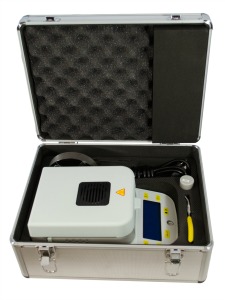
If you perform moisture analysis at more than one location in your facility you’ll soon see the value in the IL 50.001 halogen moisture analyzer now available from Tovatech. What makes it attractive is its portability – instead of buying multiple halogen moisture analyzers simply pack the IL 50.001 in its custom carrying case and take it to the test location.
Moreover, you’ll find this 50 g capacity moisture balance easy to use because programming choices have been confined to the basics – a feature that has a side benefit in terms of attractive pricing.
Superior Performance in a Halogen Moisture Analyzer
Attractive pricing is not at the “expense” of superior performance in this compact, 5-pound 120-volt moisture analyzer. Only 6.5” wide, 11” deep and 5” high, it offers the following performance specs:
- Readability: 0.001 g, 0.01% moisture
- Repeatability: 0.3% (3 g
Pipette Cleaning with an Ultrasonic Cleaner
Calibrated glass tube pipettes can pose difficult cleaning challenges especially when used to dispense reagents that tend to cling to internal walls. The process can be extremely labor intensive and can call for multiple cleaning steps before the pipettes can be used with a different reagent. An added challenge is avoiding breakage when cleaning pipettes. Careful handling is called for, which can add to cleaning time. If your lab employs pipettes in multiple quantities you should consider using an ultrasonic cleaner to help speed the operation.
Widely used for cleaning medical and surgical instruments, ultrasonic cleaners use ultrasonic energy to remove contaminants prior to disinfecting or sterilizing. Instruments are placed in mesh baskets and immersed in an ultrasonic cleaning solution. Ultrasonic cleaners create billions of microscopic bubbles that implode on contact with instrument parts in a process called cavitation. The action blasts away the most tenacious organic substances. With simple modifications, … Read the rest
Safe Vaccine Storage Check List
Updated versions of three vaccines have been recommended by the World Health Organization for the 2012-2013 flu season according to the Centers for Disease Control. In order to avoid vaccine deterioration it is essential that healthcare facilities take special precautions in vaccine storage and handling especially as it related to vaccine storage temperature. Inoculation centers should use vaccine storage refrigerators designed to maintain accurate cold chain storage temperatures. Residential and dorm-type units are not likely to maintain correct temperatures, which can result in loss of potency and the need to revaccinate – not to mention the cost of lost product.
Check Recommended Vaccine Storage Temperatures
Influenza vaccine manufacturers provide recommended storage temperatures for both LAIV (live attenuated influenza vaccine) administered as a nasal spray and TIV (trivalent influenza vaccine) administered as a flu shot. According to the CDC LAIV is shipped at 35°F – 46°F (2°C-8°C) and should be stored … Read the rest
